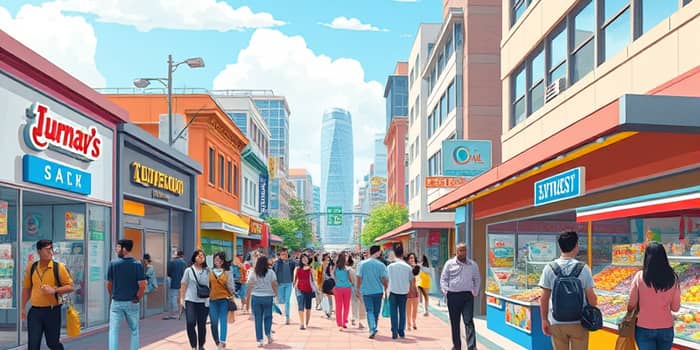
As inflation cools and consumer confidence steadies, the retail landscape is transforming with unprecedented opportunities. This moment calls for innovation, resilience, and strategic insight.
In May 2025, the annual Consumer Price Index rose just 2.3%, near the Federal Reserve’s 2% target. Monthly gains were a mere 0.1%, signaling a continued downward trend from previous years that began after the 9.1% peak in mid-2022.
With the core PCE-deflator at 2.5% year-over-year—the lowest since March 2021—retailers are finding price pressures easing. Goods inflation actually turned negative, falling 0.4% in April, while services inflation held steady at 3.3%. This shift is unlocking fresh opportunities for both established brands and emerging entrepreneurs to recalibrate pricing and promotional strategies.
Despite the cooling overall, many households remain cautious. A clear defensive shift in spending habits has emerged, with consumers prioritizing necessities over luxuries. Essentials like food and beverages saw a modest 0.3% increase in May, and 40% of shoppers reported unchanged budgets for staples.
In contrast, discretionary categories posted mixed results. Motor vehicles and building materials dipped 3.5% and 2.7% month-over-month, reflecting tightened wallets and tariff concerns. Food-at-home prices remain 25% above pre-pandemic levels, fueling frustration even as the rate of increase slows.
Non-store retailers continue to outpace the market with robust 8.3% year-over-year growth in May. The National Retail Federation projects e-commerce will expand 7% to 9% in 2025, reaching as much as $1.6 trillion. This digital surge contrasts with brick-and-mortar: early 2025 saw 6 million square feet more retail space vacated than leased.
Traditional retailers are adapting by enhancing omnichannel experiences, integrating mobile checkout, curbside pickup, and personalized recommendations. For consumers, this means smoother journeys and flexible fulfillment options.
While inflation retreats, the threat of new tariffs—25% on auto parts and potential 60% on Chinese goods—looms large. Retailers face complex choices: front-load inventory ahead of duties or pass costs onto consumers. This policy uncertainty is weighing on confidence and strategic planning.
Some analysts point out that recent softness in spending may reflect cautious consumers who front-loaded purchases to beat tariff increases. Others cite lingering anxiety over global supply chain disruptions and geopolitical tensions.
To thrive amidst volatility, businesses must be both agile and customer-centric. Consider these practical approaches:
The retail rebound is underpinned by a resilient labor market. Unemployment remains low, and real wage gains are supporting purchasing power. However, if tariffs reignite inflation, wage improvements could be eroded, challenging both retailers and workers.
Successful retailers are striking a balance: offering competitive pay and training to retain talent, while leveraging automation and cross-training to bolster productivity without sacrificing service quality.
As we move deeper into 2025, the retail sector finds itself at a crossroads of promise and peril. With inflation fears easing, there is room for optimism—but only for those prepared to adapt swiftly.
Retailers who embrace digital innovation, maintain flexible supply chains, and foster authentic connections with consumers will be best positioned to capture growth. Meanwhile, consumers stand to benefit from greater choice, improved convenience, and prudent prices.
In this era of transformation, the retail industry offers a powerful lesson: adversity often sparks creativity. By viewing challenges as catalysts, businesses and shoppers alike can navigate uncertainty with confidence and emerge stronger than before.
Whether you’re a small business owner exploring your first online store or a seasoned executive steering a global brand, now is the time to act. Seize the moment, cultivate resilience, and contribute to a retail renaissance that empowers communities and fuels sustainable growth.
References













